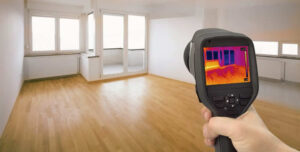6 Ways to Find Concealed Water Leaks in Your Residence
6 Ways to Find Concealed Water Leaks in Your Residence
Blog Article
They are making a few good pointers about Detecting hidden plumbing leaks in general in this post followed below.

Early detection of leaking water lines can mitigate a possible disaster. Some tiny water leakages might not be noticeable.
1. Analyze the Water Meter
Every residence has a water meter. Inspecting it is a surefire way that helps you uncover leakages. For starters, switch off all the water sources. Ensure no one will certainly flush, use the tap, shower, run the washing equipment or dishwashing machine. From there, most likely to the meter as well as watch if it will transform. Because no person is using it, there need to be no movements. That indicates a fast-moving leakage if it moves. If you identify no modifications, wait an hour or 2 and also check back once again. This suggests you might have a slow leak that might also be below ground.
2. Inspect Water Usage
If you detect abrupt adjustments, regardless of your intake being the very same, it suggests that you have leaks in your plumbing system. An abrupt spike in your costs shows a fast-moving leakage.
A consistent boost every month, also with the very same behaviors, reveals you have a sluggish leak that's also gradually rising. Call a plumber to completely inspect your residential property, specifically if you feel a warm area on your floor with piping below.
3. Do a Food Coloring Examination
When it comes to water usage, 30% comes from commodes. If the shade somehow infiltrates your dish during that time without flushing, there's a leakage between the container as well as bowl.
4. Asses Outside Lines
Don't forget to inspect your outdoor water lines too. Needs to water permeate out of the link, you have a loose rubber gasket. One tiny leakage can waste heaps of water as well as spike your water bill.
5. Inspect and Examine the Situation
Homeowners ought to make it a habit to examine under the sink counters as well as even inside closets for any kind of bad odor or mold and mildew growth. These two red flags suggest a leakage so punctual focus is called for. Doing routine assessments, also bi-annually, can save you from a significant trouble.
Check for stainings and also compromising as a lot of home appliances and also pipelines have a life expectations. If you suspect dripping water lines in your plumbing system, do not wait for it to intensify.
Early detection of leaking water lines can minimize a possible catastrophe. Some tiny water leakages might not be visible. Checking it is a proven method that assists you uncover leaks. One tiny leak can waste heaps of water as well as surge your water bill.
If you presume leaking water lines in your plumbing system, don't wait for it to intensify.
WARNING SIGNS OF WATER LEAKAGE BEHIND THE WALL
PERSISTENT MUSTY ODORS
As water slowly drips from a leaky pipe inside the wall, flooring and sheetrock stay damp and develop an odor similar to wet cardboard. It generates a musty smell that can help you find hidden leaks.
MOLD IN UNUSUAL AREAS
Mold usually grows in wet areas like kitchens, baths and laundry rooms. If you spot the stuff on walls or baseboards in other rooms of the house, it’s a good indicator of undetected water leaks.
STAINS THAT GROW
When mold thrives around a leaky pipe, it sometimes takes hold on the inside surface of the affected wall. A growing stain on otherwise clean sheetrock is often your sign of a hidden plumbing problem.
PEELING OR BUBBLING WALLPAPER / PAINT
This clue is easy to miss in rooms that don’t get much use. When you see wallpaper separating along seams or paint bubbling or flaking off the wall, blame sheetrock that stays wet because of an undetected leak.
BUCKLED CEILINGS AND STAINED FLOORS
If ceilings or floors in bathrooms, kitchens or laundry areas develop structural problems, don’t rule out constant damp inside the walls. Wet sheetrock can affect adjacent framing, flooring and ceilings.
https://www.servicemasterbyzaba.com/blog/how-to-detect-water-leakage-in-walls/

We are very intrigued by Leaking water lines and I'm hoping you enjoyed reading the entire entry. For those who appreciated our post kindly remember to share it. I praise you for your time. Kindly come by our website back soon.
Report this page